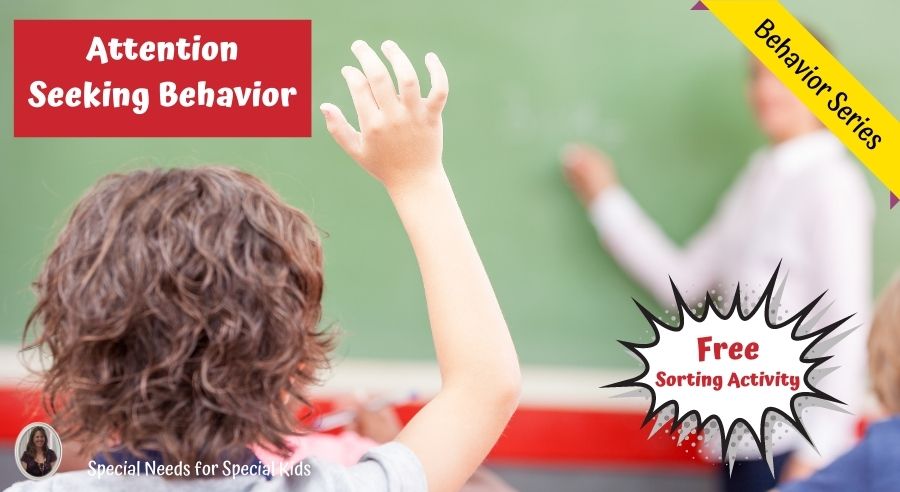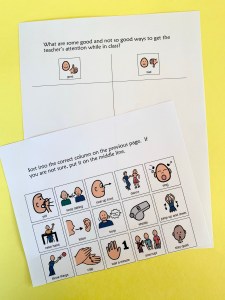Attention seeking behavior is a common behavior problem in the classroom as well as at home. Especially in the classroom, we get so busy that often the only way a student can get us to stop and listen to them is by using attention seeking behaviors. And, as with most common behaviors, they are quite effective. Below are some strategies and a free activity you can use in your classroom today to help minimize attention seeking behaviors.
Is it attention seeking behavior?
First, let’s figure out how you know it is attention seeking behavior rather than one of the other functions we have talked about. There is an easy experiment you can run that will give you the answer.
1. Identify a specific behavior
2. Ask someone to track how many times that behavior occurs during a normal hour of your classroom routine.
3. Depending on the frequency, spend 5-10 minutes intentionally giving that student an excessive amount of attention. Does the targeted behavior occur during that time? Is it at the same, increased, or decreased frequency?
4. Repeat step 3 but plan to purposefully ignore (as much as is safe to do) the targeted behavior. Does the behavior occur during that time? Is it at the same, increased, or decreased frequency?
So, as you can probably guess, if the behavior goes away or decreases in step 3 and/or increases in step 4 then you have an attention seeking behavior.
Now that you know what you are dealing with, there is a great 3-pronged strategy to deal with attention seeking behavior. As with all behaviors and behavior plans, this is not a quick fix and will take some intentional planning and collaboration with other adults to make it work. But it is effective in the long run.
Step 1: Ignoring the attention seeking behavior
This may seem obvious and easy, but we all know how truly difficult it can be. It also can be, at times, dangerous. The problem arises that as we ignore the behavior, that typically gets attention, there will ABSOLUTELY be an extinction burst. The student will try harder, louder, and bolder ways to get your attention. So, have a plan.
Will you simply ignore, walk away, from the attention seeking behavior? Will you give a subtle hand signal or visual cue that the student’s behavior is not acceptable? Make sure you think about it ahead of time and then share that plan with all the adults who will be working with that student.
If you know you may need to physically intervene, do so in a way that provides as little attention as possible. Gently guide the student to a safer location. Do not speak and try to make little or no eye contact. Hopefully, you will be able to totally ignore the behavior, but in a classroom setting with other students present, we often must take into account the safety of others.
Step 2: Giving random and intermittent positive reinforcement
Again, this will take some planning ahead of time. Decide as a team what that positive reinforcement will look like. Will you give the student a high five, a sticker, a token for their token board, or even a break to enjoy a favorite activity. Provided you know the student well, pick something that is truly reinforcing to the student.
Decide how frequently you will deliver this random reinforcement. It needs to be at least as frequent or more frequent than the attention seeking behavior typically occurs. That means you will need some initial data before you start. Make sure you vary the location and time you deliver this random positive reinforcement.
Step 3: Teaching a replacement behavior
At the same time you are doing steps 1 and 2 above, you want to be teaching your student how to appropriately request your attention. Is it raising your hand, and then waiting to be called on? Is it turning a card from green to red on their desk to indicate help is needed. As with all interventions, this needs to be specifically taught. Consider adding a social story and other visual cues to remind the student when and how to use this new behavior.
Download this free sorting activity on getting the teacher’s attention by clicking the button below.
What if it doesn’t work?
Sometimes, it may feel like, despite your best attempts, the attention seeking behavior is not going away, or may even feel like it is increasing. If that is the case, consider the following.
1. Are you giving random positive reinforcement frequent enough? Consider increasing how often you are delivering random praise. In addition, make sure it is intermittent. It should not be so predictable (ie every 10 minutes), that the student is anticipating when it will occur.
2. Is the random positive reinforcement you are delivering truly reinforcing to that student? Sometimes, what we think should be enjoyable and “appropriate” to the student, especially given the classroom setting, is not always received that way by the student. Some students love a high-five, some students love access to a stress ball, and some students just want your undivided attention for a moment. Ask other adults for their opinion. Do they think the student enjoys the reinforcement you are delivering? If you are not sure, then switch it up and try something new.
3. Ask yourself if you are truly ignoring the attention seeking behavior. Again, other’s observations can be quite helpful here. You may not even realize how you are positively reinforcing the attention seeking behavior. Of course, none of us are perfect. There will be times you may lose your patience and feed back into that cycle. That is okay, just recognize it and do better next time. Just realize, it can be just a look, a sigh, or a gesture that we make in frustration that is all that student need to feed that appetite for attention.
I hope this series on behavior has been helpful. I have had a lot of questions and specific scenarios. Every classroom and every student are different. It is difficult to write one post that covers even half of the situations. Is the scripting a student does a self-calming strategy, an attempt get out of work or escape the current stimuli and go inward or is it an attention seeking behavior. It is never an easy answer. But you know you finally got it right when the behavior starts to decrease. And remember, every time a behavioral intervention fails you have more information you can use to come up with a more effective intervention.
Be sure to check out the other posts in this series:



3 Comments
Comments are closed.